Agronomy for early sown canola
Author: Martin Harries, Mark Seymour, Jackie Bucat, Bob French, Sally Sprigg: DAFWA | Date: 28 Feb 2017
Key messages
- Agronomic management of canola changes considerably when sowing very early.
- There was a large yield benefit from establishing canola in mid-vs late April of approximately 40 kg/ha/day but the additional benefit of sowing in late March vs mid-April was only about 10 kg/ha/day.
- Climatic and agronomic risks increase with early sowing.
Aims
To consolidate information and provide guidelines for best bet management of canola sown at or before mid-April.
Background
In recent years March and April rains have provided good opportunities to push the boundaries of early sowing of canola. The Tactical Break Crop Agronomy Project identified that there was little information as to whether there are changes required in agronomy to give the best chance of success from early sowing and subsequently implemented a wide range of trials that relate to the topic.
Results
Yield
Two time of sowing x variety trials were implemented: 1) 2015 Binnu April 15 vs April 29, 2) 2016 Wongan Hills March 31 vs April 15. At Binnu site mean yield was 1322 kg/ha. Averaged across all varieties TOS 1 (April 15) yielded 1647 kg/ha compared to 997 kg/ha for TOS 2 (April 29). Hence delaying sowing by 15 days led to 650 kg/ha less yield – equivalent to a loss of 43 kg/ha/day. At this short season site using the highest yielding variety rather than trying to match variety maturity to sowing date was the best option as there was no increase in yield with the longer season varieties at the earlier sowing date, (Harries and Seymour 2015).
At Wongan Hills site mean yield was 2755 kg/ha. Averaged across all varieties TOS 1 (March 31) yielded 2853 kg/ha compared to 2658 kg/ha for TOS 2 (April 15). Hence delaying sowing by 15 days led to 195 kg/ha less yield, which is equivalent to an average loss of 13 kg/ha/day. The effect of sowing time by variety was almost statistically significant (P = 0.066) and differences in the response to TOS were associated with variety maturity length. Mid-season 5 and 6 series mid and mid/late varieties responded best to March sowing while shorter season 4 series varieties produced similar or less yield from earlier sowing (Figure 1). These results match well with NVT data which indicate that the longer season varieties yield better relative to shorter season varieties at high yield potential sites. These often correlate to longer season length sites (See paper titled “Is it worth switching to a longer season canola variety when you sow in March? - very early sown canola variety trial, Wongan Hills, in 2017 update proceedings).
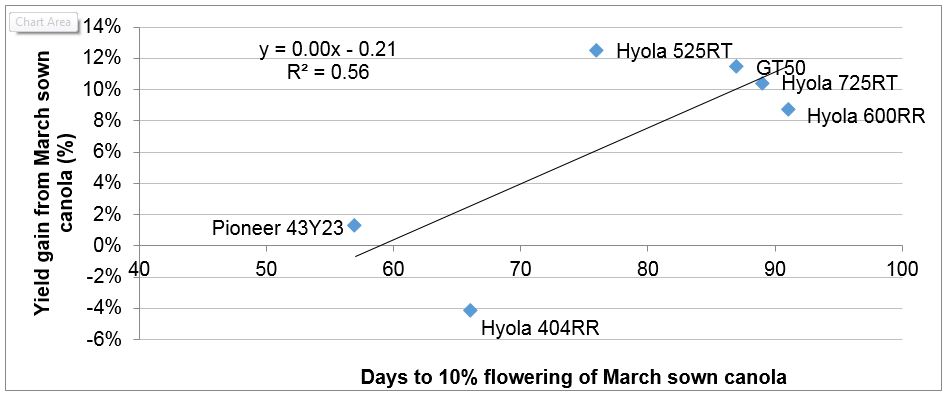
Figure 1. Yield gain of 6 canola varieties sown on March 31 (TOS1) and April 15 (TOS2) at Wongan Hills in 2016.
Seed quality
Oil concentration is affected by many variables such as, variety, nitrogen nutrition and most markedly environmental conditions at seed fill. Hence there is unlikely to be a consistent response of seed oil content to sowing time. In the 2015 and 2016 time of sowing trials there were significant varietal responses but no significant differences in oil content between the sowing times.
Establishment
Several trials were run in 2016 across sites from Merredin to Geraldton which looked at how establishment from a mid-April sowing was impacted by seed depth, seed size and hybrid vs OP. Hybrid and OP varieties were sown at 3 seed depths from 1 to 7cm and seed was graded into three size lots from each variety. The reason for testing seed depth was to see if chasing moisture at depth would improve establishment when sowing early, in hot conditions.
Sowing canola at 1cm produced higher establishment than sowing at 3 or 7cm, even when sowing in mid-April into sites with sub-soil moisture (20-50mm of rain received 1 week prior). Measurements of soil moisture at the three seeding depths of 1, 3 and 7cm along with deeper measurements indicated that soil moisture at the top 1cm was similar or greater than at depth in the two weeks following sowing despite ambient temperatures in excess of 30°C. In difficult conditions hybrid seed was better able to establish than OP canola. Sowing small OP seed deep resulted in very poor establishment and reduced yields (Figures 2 & 3). (For more details see paper titled “Canola establishment: seed depth, seed size and hybrid vs OP, in 2017 update proceedings).

Figure 2. Mingenew site sown April 15, establishment by seed size and seed depth (a) ATR Bonito (b) Hyola 559TT
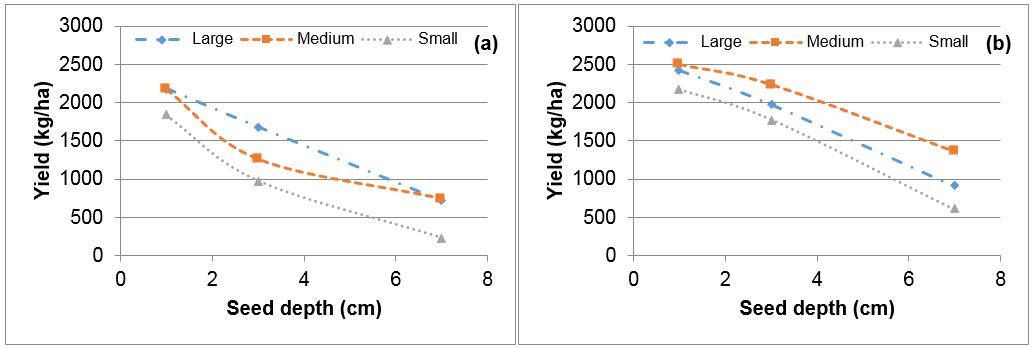
Figure 3. Mingenew site sown April 15, yield by seed size and seed depth (a) ATR Bonito (b) Hyola 559TT
The gross margin of both the OP and the Hybrid decreased as sowing depth increased, in line with yield. The effect of seed size on gross margin was much greater for the OP hence it is important to grade the OP seed while there was no benefit in grading the commercial hybrid seed lot as it was already large, 180,000 seed/kg. The highest gross margin treatment of the OP and the hybrid were similar at $991 and $866 respectively. The OP yielded less but this was off-set by lower input costs and a commodity price premium.
Plant density
Establishment rates in commercial fields range from 90% or more through to less than 30% depending on seeding conditions and harsher conditions can be expected at very early sowing dates. This inevitably means that there will be paddocks where the target density is not achieved. In 2014, 2015 and 2016 trial plots with 5 plants/m2 sown in the northern region in mid-April yielded over 1.5 t/ha. The conclusion was that in situations where weeds are not an issue density must be less than 10 plants/m2 before considering re-sowing. In fact some growers in the northern agricultural region are targeting 15-20 plants per/m2 in wide rows (50-60cm) as a method to reduce intraspecific competition of seedlings and drought stress. Ben Cripps, who farms at Binnu tested interactions of row spacing and seeding rate and concluded “We found the highest-yielding combination in our two years of trials was wide rows with low seeding rates. Lifting the seeding rate suppressed yields in both the narrow and wide rows, especially in dry conditions where plants in the narrow rows got stressed earlier” (Williams 2015).
Seedling water stress
As the sowing date is brought further forward the risk of not receiving substantial follow-up rains increases. Figure 4 shows the probability of a second wet period (plant available soil moisture > 50% at 0-10cm) occurring a week or more after the break (15mm or more received in 2 days or less). The earlier the break the greater the chance of soil moisture dropping below 50% for a long period after the rain event. For example when a break of 15mm occurs between March 20 and April 5 the probability of a second period of wet soil not occurring for at least 13 days after the break is 45%. For all the early sowing periods, March 20 through to April 21 the graph shows there is a 25 to 30% chance of not having a second sowing opportunity for 30 days or more. Hence missing a sowing opportunity from an early break will frequently lead to a large delay in sowing date.
The earlier the crop is sown the greater the likelihood of a long period of low soil moisture after sowing, and risk of seedling drought. Mitigating the period of seedling drought stress is a key to the success of early sowing. Moisture stress after sowing will be reduced if there is a substantial amount of stored soil moisture, hence summer rainfall and/or cropping into a fallow paddock may be less risky options for early sowing. As mentioned above reducing intraspecific competition along with increasing water harvesting in wide rows is being used on northern region farms to delay the onset of plant stress should conditions be dry for an extended period after sowing.
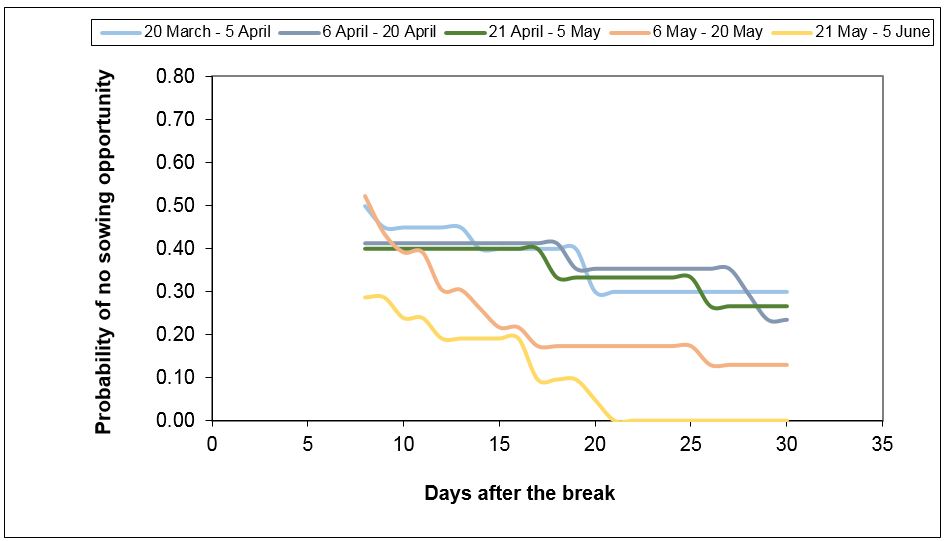
Figure 4. Probability of there not being a sowing opportunity after different break of season dates, Mingenew climate data.
Nutrition
Many soils will have adequate P and K to carry extra yield from early sowing. Sampling commercial focus paddocks showed that P soil levels were high with an average of 36 mg P/kg in the top 10 cm and 108 canola tissue tests indicated 81% adequate or above, 16% marginal, and 3% deficient. For K 85% of paddocks had over 50 mg/kg and 108 canola tissue tests indicated 83% adequate or above, 15% marginal, and 2% deficient. For sulphur sixty-nine per cent (69%) of paddocks had a 0–30cm S content considered adequate for canola (>7.5mg S/kg) and 108 canola tissue tests indicated 82% adequate or above, 13% marginal, and 5% deficient. Canola grain contains around seven times as much sulphur as wheat, at approximately 10 kg/t, hence additional sulphur will be required for higher yielding crops.
Within the current Tactical Break Crop Agronomy Project there has been an extensive field trial program to assess nitrogen requirements. In the majority of experiments delaying nitrogen application to 12 weeks – near flowering produced similar results to other times of application, Figure 5 (Seymour et al 2015). Delaying post-emergent N application until flowering reduces up-front costs and the financial risk of early sowing.
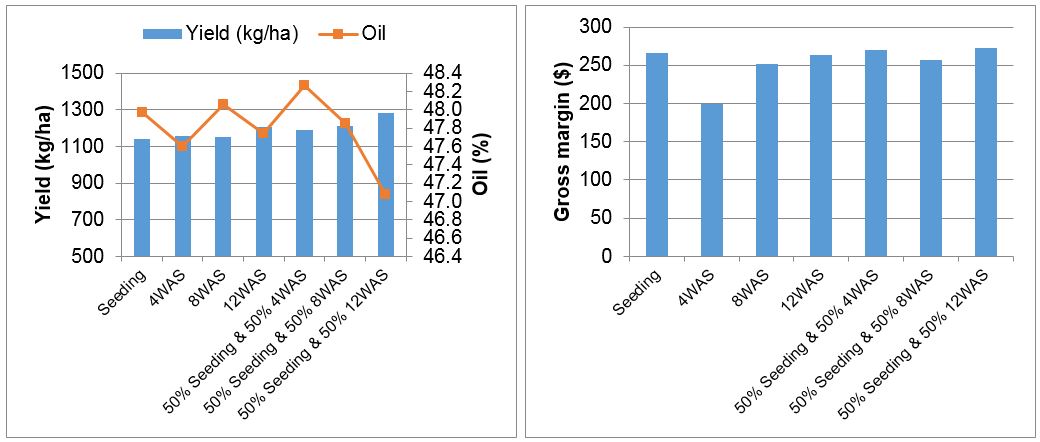
Figure 5. The effect of applying 50 kg/ha of N at different timings on canola yield, seed oil content and gross margin.
Total N requirement is likely to be higher from earlier sowing due to increased yield as shown in APSIM outputs, Figure 6. Because very early sown canola crops are most commonly sown in conditions with good levels of sub-soil moisture N budgeting should account for mineralisation of organic N over summer months.
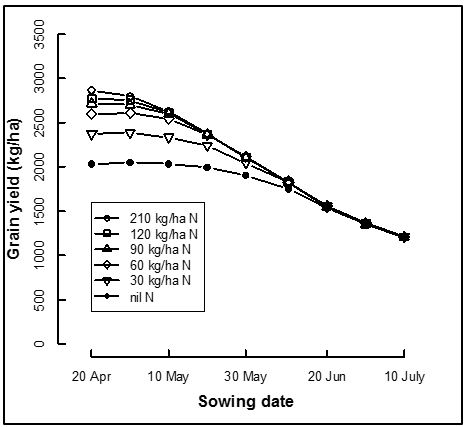
Figure 6. APSIM yield predictions for canola at various nitrogen input levels and sowing dates using, Mingenew climate data.
Other things to consider
There are a number of additional things to consider with very early sowing. In a high frost risk area early sowing is likely to increase the frost risk. Conversely early sowing in the northern region may ensure flowering occurs prior to conditions likely to cause heat stress. The dynamics of pests and diseases will change. For example when using Round-up Ready varieties growers need to factor in that plants can reach the 6 leaf stage rapidly in warm conditions and be prepared to apply post emergent applications while the rest of the program is still being sown. Growers also need to be aware that the window for grass selective herbicide application is reduced and ensure these herbicides are applied prior to the crop flowering. There is an increased risk of aphid colonisation causing yield loss from both feeding damage and transmission of Beet Western Yellows Virus (BWYV). A 2015 trial at Geraldton showed that the length of the spikelet colonised by cabbage aphids is directly proportional to yield loss. Yield (kg/ha) = -141x + 1114 where x= spike length colonised in cm (R2 0.9). Early infestation with Green Peach Aphid increases the risk of transmission of (BWYV) into plants at an early development stage which increases the yield loss caused by this virus (Jones et al.).
Sclerotinia has also emerged as a major pest however it is difficult to predict disease epidemiology and make broad recommendations as to the impact of sowing date on infection and yield loss. Crop infection requires sclerotes to germinate and release ascospores; (at least 7-10 days of ongoing moisture at 10-20°C). And this must coincide with canola flowering for petal infection to occur and moist conditions once petals lodge within the crop canopy. If conditions are conducive to sclerotinia early then earlier sown crops may be at more risk due to early flowering and more biomass, however if conditions are not conducive to disease early sown crops may escape the main ascospore release period. Work is continuing within the DAFWA pathology group to better define these relationships.
Nutrient budgeting of a paddock following a high yielding canola crop also needs to be taken into account. Canola grain removes approximately twice the amount of N, P, and K of wheat per tonne and 7 times the amount of sulphur. Burning windrows will also cause changes in nutrient dynamics, losses and increases in plant availability depending on the element.
Further work
The Tactical Break Crop Agronomy group will continue a range of activities in this area; testing very early sowing with new varieties across a wider set of locations, phenology and APSIM work to better identify flowering periods and associated frost and heat stress risk periods, establishment methods in difficult conditions, defining establishment rates under different conditions and soil types more accurately and investigation of genetic variations such as emergence from depth to improve establishment in hot drying conditions.
Conclusions
There was a large yield benefit from establishing canola in mid-vs late April but this declined when sowing in late March compared to mid-April in the time of sowing trials reported in this paper. There are some agronomic changes that can be made to improve the chances of success of an early sown canola such as: sowing after a fallow or after summer rains, using heavily graded OP or hybrid seed to obtain a better establishment rate in tough conditions and altering plant density and geometry. Input costs can be reduced by applying fertiliser post emergent however there are still significant risks when sowing very early; weeds and pests need to be controlled over a long period and plants may be flowering at high frost risk times.
References
Harries and Seymour (2015) Canola variety by time of sowing, Binnu 2015 trial report.
Jones R. A. C, Coutts B. A, Hawkes J (2007). Yield-limiting potential of Beet western yellows virus in Brassica napus. Australian Journal of Agricultural Research, 58, 788–801
Seymour et al.(2015) Timing of nitrogen for canola in lower rainfall areas in WA. Perth Agribusiness crop updates 2015
Williams. M. (2015) Pushing canola boundaries in the north. GroundCover issue 116.
Acknowledgments
Thanks to the Geraldton and Wongan Hills DAFWA Research Support Units for trial management and measurements and the GRDC for project funding.
Paper reviewed by: Andrew Blake
GRDC Project Code: DAW00227,
Was this page helpful?
YOUR FEEDBACK
